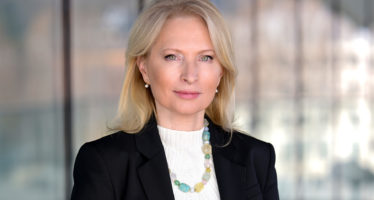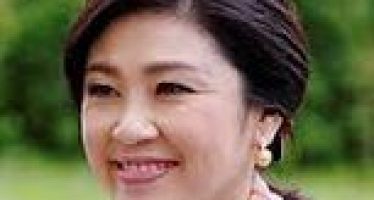Lord Waverley: Central Asian Region Revealed in All its Glory, Mystery, and History
Lord Waverley negotiated Memoranda of Understanding with each of the five parliaments of Central Asia, and was the architect of the Aktau Declaration on Joint Actions. In this first segment of a two-part series, he presents a unique insight into the region…
One is acutely aware as to how much can be achieved by first-hand engagement in a region of crucial importance that is full of potential but had once been closed for access.
Sir Halford Mackinder, the British political geographer of early 20th Century, once profiled this part of Asia in his land-based theory of world power as “Heartland”, the strategic centre of the “World Island”, and that whoever controlled it controlled the world.
Part One: Kazakhstan and Uzbekistan
Long before the advent of oil and gas as a prize, mystery and a heightened realisation of its impending post-independence importance first drew me to Central Asia. The region has a mystical resonance in the imagination, whether through the writings of the orientalists or the biographers of the Great Game. The colonial withdrawal and Soviet takeover of the region led to a steady decline in what was once a tradition of scholarship and trade, as access to the region became restricted.
The dissolution of the Soviet Union and liberalisation in China and Mongolia removed barriers to access to central and inner Asia, but the strategic importance and the global business and academic community are only now beginning to understand Central Asia. I wish to elevate the profile of a region that has recently been substantially neglected in foreign policy terms, but which has become greatly relevant to the global political stage and regional stability.
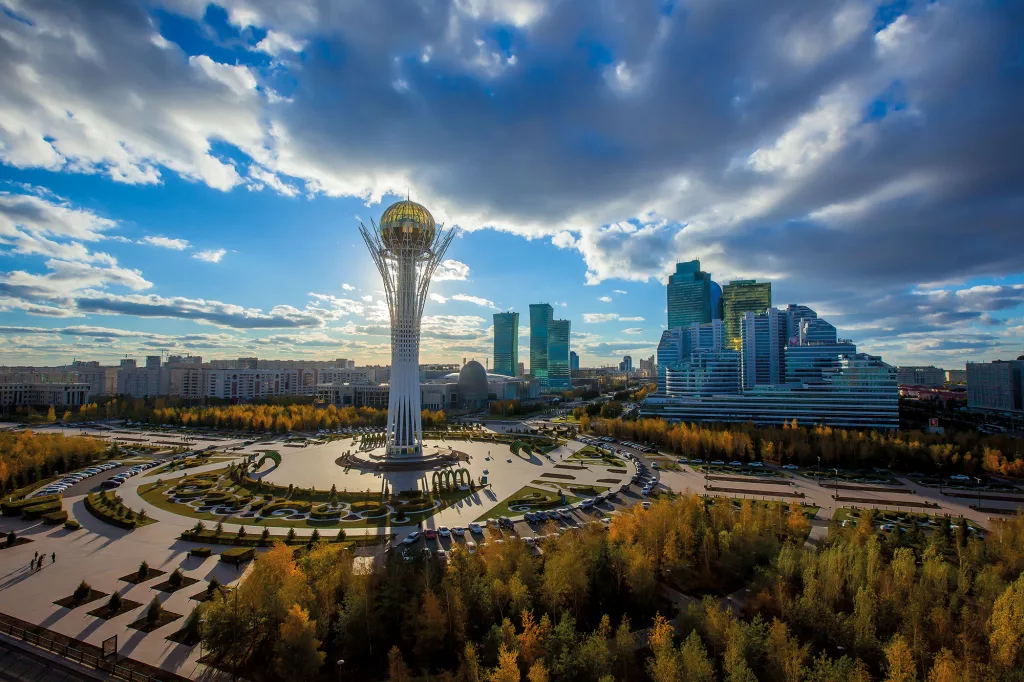
Kazakhstan: Astana
The prospective importance can scarcely be overstated, with interests such as counter-terrorism, energy security, democratisation, and the rule of law essential.
Thanks to an innovative pipeline grid, a new golden triangle of trans-Caspian oil and gas resources is emerging that will transform the regional economic potential. Central Asian countries are characterised by predominantly moderate and secular governments which should be viewed as reliable partners and rational actors on key issues. They remain favourably inclined towards western countries and keen to partner with social, economic, and political cultures.
We should be acting now to help secure their futures by understanding the needs amid the powerful spheres of influence exerted by adjacent nations. It is incumbent upon us to listen intelligently, to welcome, and to benefit from these new voices at the table of nations. The need for a balanced foreign policy that accommodates this geopolitical approach cannot be overlooked. Afghanistan is a part of the Central Asian nexus and has natural regional affinities. Countries there understand the various ethnic cultures, and essential economic development will filter from the north.
The region possesses abundant agricultural, mineral and energy resources, with great potential for renewable energy, including hydropower and solar. It contains all the necessary ingredients for industrial growth and has a widely educated workforce. Scientific potential is enormous, bearing witness to considerable technological sophistication.
However, industries such as cotton monoculture require vision and assistance in the continued transition from a command economy to market mechanisms that create jobs, exports, and opportunities. It is predicted that these countries will experience strong future economic expansion with economic engines benefitting from oil and gas field production in the years ahead, and position the region for solid growth, development, and diversification. This will be fuelled by high global commodity prices and stronger domestic demand.
The hydrocarbons sector is the backbone of the larger economies, but structural challenges undermine the full development of the natural resources sector. The need for local technical skills and the limited financial capacity to develop the energy sector make the search for foreign investors a priority, while corruption remains a concern for some foreign investors. Regional interests should not fall into the trap of a single-commodity economy. There are real opportunities in the form of energy co-operation beyond hydrocarbons, and the potential for sustainable partnerships for outside interests is immense.
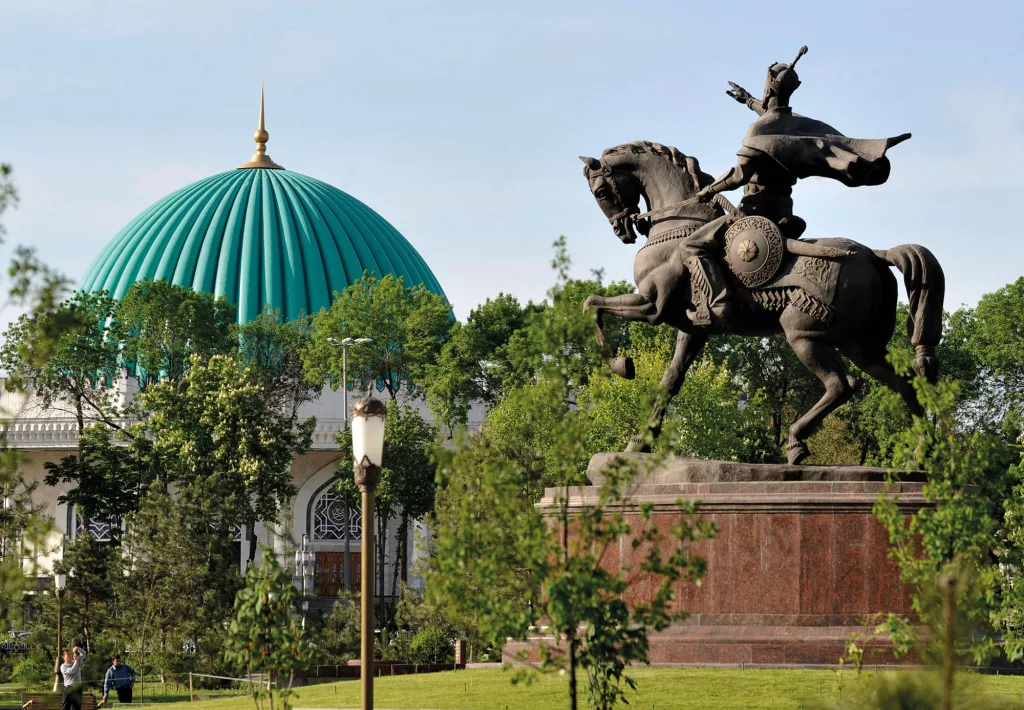
Tashkent: Amir Temur Monument
The priorities of advancing dialogue on European security through the Corfu process launched to take security dialogue forward with political, military, and economic dimensions, go together with a theme of promoting inter-ethnic and religious tolerance. The Shanghai Cooperation Organisation, comprising most of Central Asia, has achieved considerable results in developing international contacts, as well as in implementing initiatives to strengthen security and stability to combat terrorism, extremism, and separatism.
Management of the key pipelines that serve as a gateway for Central Asia are evolving into a dynamic Eurasian artery of economic growth and development. Transport corridors will link Central Asian countries with wider regional continental trade and transport networks, further strengthen the sovereignty of the regional states, and facilitate the opening of the political and economic systems.
For all these reasons and more, it is essential to push relationships forward on all fronts, and seek to balance the interests of the US and China in the multi-vector policies of the Central Asian states.
The fragile, nascent political systems should be encouraged towards the growth of democratic and anti-authoritarian regimes. This will succeed if a long-term view of reform is taken. Democracy is an evolutionary process and should be seen as a partner, not a preacher. The democratisation of state power and governance, ensuring freedom of choice and the development of electoral legislation, reforming the judicial and legal systems, and developing civil society — these are all areas in which there can be useful engagement in the spirit of partnership and co-operation.
This would strengthen the parallel-to-trade objectives in advocating the benefits of good governance, transparency and accountability, freedom of the press and human rights. Engagement is essential with the Central Asia states that have completed the transition stage of their independence. Thirty years on, it is a new game — and a positive one — in a region that is of priority strategic interest.
Kazakhstan
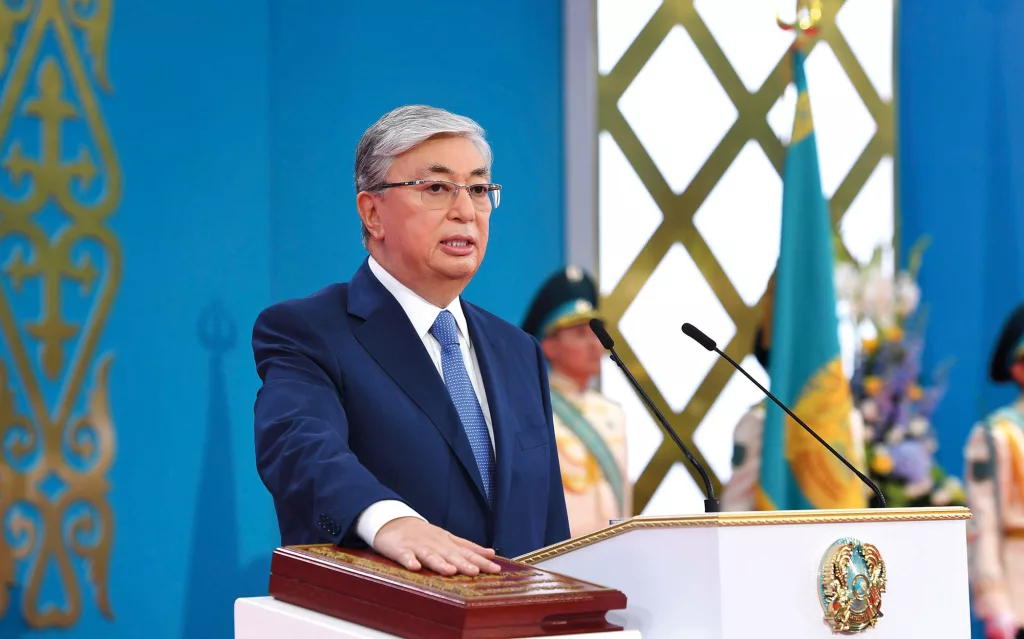
Inauguration: President Kassym-Jomart Tokayev
This new country is an old nation that has been shaped by a particularly dramatic set of circumstances. There have been successive waves of invasion, immigration and migration along the Great Silk Road, which gave birth to the mix of cultures and traditions which make the country what it is today. It is the ninth-largest country in the world, with an area of 2,724,900 square kilometres, and is the largest landlocked country in Europe and Asia.
The country is best known historically as a crossroads of people and cultures. Over the centuries, the Kazakh steppe saw some of the world’s greatest conquerors — Alexander the Great, Timur, and Genghis Khan — and was neighbour to the Safavid Empire of Persia, the Mughal Empire of India, and the many great Chinese dynasties while forming part of the Mongol, the Timurid, and Russian empires.
The Kazakh khanates emerged in the centuries following the fall of the Mongol Empire, as the people of Central Asia consolidated their land and created the outlines of the first Kazakh nation. The Kazakh Khanate, located roughly on the territory of present-day Kazakhstan, was founded by Sultans Kerey Khan and Zhanibek in 1465. It was the first sovereign state of the Kazakhs.
The formation of the independent Kazakh Khanate began when several tribes, under the rule of Sultans Kerey and Zhanibek, departed from the Khanate of Abilkhaiyr Khan. The sultans led their people toward Monğolistan, eventually settling in the area between rivers Chu and Talas in south-eastern modern Kazakhstan, and founded an independent state.
Between the 17th and 19th Centuries, the Kazakh people fought numerous wars against Chinese and Dzungar tribal confederations, as well as Russian expansion, but survived intact. Kazakhstan was fully incorporated into the Russian Empire in late 19th Century and became the second-largest republic of the Soviet Union of the 20th Century. On October 25, 1990, Kazakhstan declared itself a sovereign state, and on December 16, 1991, it proclaimed full independence.
Political Background
The Republic of Kazakhstan became a sovereign state in a new era in 1991. The country’s independence was first acknowledged by the US, followed by China and the UK. At the dawn of its independence, Kazakhstan embarked on a series of reforms aimed at shifting the country’s economy from a centrally planned system to a modern free market model, and changing its one-party government to a multi-party democratic system.
Over the ensuing 31 years, Kazakhstan has established diplomatic relations with 186 countries and transformed itself into one of the dynamically developing economies of Eurasia, with a respected diplomatic voice on the world stage.
Today, Kazakhstan is entering a new stage of development. President Kassym-Jomart Tokayev launched a process of political transformation to build a just and fair nation. The primary aim is to make the justice central to state policy, to improve the welfare of the people and respond to their needs.
This country is gradually implementing large-scale domestic political and socio-economic reforms aimed at a more sustainable and diversified economy, a more equitable society, and a competitive and resilient political system. The Head of State’s initiative to limit the presidency to a single seven-year term, without the right to re-election, provides a solid foundation for a stable long-term policy course, and guarantees the permanence of the democratic reforms. This is an initiative without precedent, aimed at the long-term stabilisation of the political system, eliminating the risks of power monopolisation, and strengthening the basic principles of democracy.
The president has announced a new economic policy, the development of a real economy, a decrease in the government’s stake in the country’s GDP, a reset of the public administration system, and implementation of rule-of-law principles. The main objective is to ensure inclusive growth and wellbeing for all citizens. The most important principles of this policy are the promotion of entrepreneurship, competition, and the fair distribution of wealth.
Trade and Investment
Kazakhstan has a rich past — and great opportunities to become one of the world’s most competitive economies. Trade plays an important role, and the country is well-positioned to benefit from the growing markets of China, Europe, and Central Asia. Its history echoes the epic silk route of centuries past, and its present with two-way rail and road traffic between China and Europe.
Kazakhstan has built on its continued success and religious, social, and political harmony to become a magnet for large investors — and a locus of further innovation. Its private sector foreign direct investment (FDI) has amounted to over $400bn since independence, and has played a central role in the country’s rapid development. But long-term foreign investors’ interest can be sustained only by the willingness to create a welcoming, supportive, and engaging business environment.
Kazakhstan has worked hard to create such a climate, not only for its own business sector, but also for the increasing number of foreign investors. Social stability is key, as is the evolution of legal frameworks to bolster investor confidence.
A multi-level system of state support for investors has been established, including industry benefits and an investment environment of exemptions from taxes and customs duties, and land grants. A strategic investment agreement has been introduced to provide special conditions for investment projects worth more than $50m, including the stability of legislation for 25 years, the reimbursement of capital infrastructure costs, the possibility of extending preferences under the special economic zones, and other customised measures.
Amid a pandemic-induced slowdown of economic activity, the Kazakh government has taken concerted efforts to reassure domestic and foreign investors that all obligations and guarantees of the state will be fulfilled.
Kazakhstan possesses the world’s sixth-largest natural mineral reserves deposits, and ranks a global 10th for total mineral production (excluding oil and gas) with deposits of around 60 precious and non-ferrous metals. The government has designed incentives such on tax, customs preferences, provision of land plots and basic infrastructure to support investors.
A strong, world-class financial sector is being developed. The Astana International Financial Centre (AIFC), an independent court based on English law, has been created. It hosts more than 1,700 companies from 71 countries, providing an international common-law framework, an independent court and arbitration centre, tax benefits, and a special labour regime.
With the second-largest reserves in Eurasia, Kazakhstan is a reliable supplier of oil and gas, a vital ally in the current global energy crisis. The country accounts for 45 percent of the global uranium market output, and is a competitive and reliable long-term supplier of nuclear fuel for powerplants around the world.
Opportunities in green energy sector, with the fostering of economic development and the advancing of energy transition, is of crucial importance for Kazakhstan as it sets out to meet a goal of achieving carbon-neutrality by 2060.
The government of Kazakhstan continues to work to further improve the investment climate by ensuring rule-of-law, safeguards, and protection of intellectual property rights. Its key objective is to maintain stability and predictability for foreign investors.
Foreign Policy
Since gaining independence in 1991, Kazakhstan has consistently strengthened its position in the international arena as a peace-loving and open-minded nation — and a reliable partner in global and regional affairs.
The country views itself as a middle-ranking power with a multi-vector foreign policy that makes a significant contribution to the formation and implementation of the global and regional agenda in security, co-operation, and development.
In 1992, with the goal to promote peace and security in the entire Asian region, Kazakhstan initiated the Conference on Interaction and Confidence Building Measures in Asia (CICA). This pan-continental security forum implements confidence-building measures, and forges and enhances political dialogue and interaction to promote peace and stability in the 28 member states.
Kazakhstan was once home to the Soviet Union’s Semipalatinsk testing site, where some 450 nuclear devices were tested between 1949 and 1989 — the equivalent of 20,000 Hiroshima bombs. After the collapse of the Soviet Union, Kazakhstan inherited the fourth-largest nuclear arsenal in the world, but closed Semipalatinsk and dismantled the nuclear arsenal 30 years ago. It has clearly indicated that CICA, as a responsible community of nations, can break new ground on national safety, helping economies to mature, creating jobs, and embracing partnerships for the future.
Convinced that spiritual and religious leaders play a significant role in fostering inter-ethnic and inter-religious harmony and respect, Kazakhstan convened (and has since hosted) seven high-level meetings of the triennial Congress of the Leaders of World and Traditional Religions since 2003. The most recent was held last September, with the participation of Pope Francis. The congress provides a platform for dialogue between religious and political leaders for the sake of peace.
Based on the reach and success of the country’s multi-vector foreign policy, Kazakhstan became the first Central Asian country elected to serve as a non-permanent member of the United Nations Security Council from 2017-2018. In 2021, it was elected a member of the United Nations Human Rights Council (2022-2024) of the UN General Assembly in New York. In 2015, Kazakhstan signed the Enhanced Partnership and Co-operation Agreement (EPCA) with the EU, which governs trade and economic relations. After ratification by all individual member states, the agreement entered into force on March 1, 2020.
Kazakhstan has been a staunch proponent of multilateralism, which it values for forging the international community’s collective vision and approach to solving global and regional problems based on multilateral consultations and agreements. The country has long been recognised the inextricable nexus between security and development at national, regional, and global levels — and it has called on the international community to develop integrated approaches to cross-border security, conflict resolution, and peace-building efforts in post-conflict countries.
Cultural and Tourism
Kazakhstan’s centuries-old history and multifaceted cultural heritage form essential parts of modern life in the country.
- Horsemanship. The domestication of horses, and the development of equestrian culture, originated in the territory of modern Kazakhstan. Ancestors of the Kazakhs create protective armour for horse and rider, and invented riding aids such as stirrups.
- Golden Man. In 1969, “Kazakhstan’s Tutankhamun” was discovered near the town of Issyk. The skilful craftsmanship of the golden warrior garment revealed a rich mythology, reflecting the power and aesthetics of the Steppe civilisation.
- The Silk Road. The unique location of Kazakhstan in the heart of Eurasia has contributed to the emergence of transit corridors between various regions and civilisations. These routes were transformed into the Silk Road system, a transcontinental network of trade and cultural ties across the length and breadth of Greater Eurasia.
- Apples and tulips. The foothills of the Tien Shan Mountain range are the historical homeland of apples and tulips. The “original” apple tree — the Sievers tree — originates from Kazakhstan, and around the world there are now more than 3,000 varieties of cultivated tulips, most of which are descendants of ancient Kazakh flowers.
Kazakhstan is home to over 27,000 ancient monuments, including the Golden Warrior, a Saka prince clad in gold armour, and five UNESCO World Heritage sites. Three are cultural sites — the Mausoleum of Khoja Ahmed Yasawi, Tamgaly, home to 5,000 ancient petroglyphs, and the Routes Network of Chang’an-Tianshan Silk Road Corridor — and two natural sites, the Saryarka plains (world-famous for birdwatching), and the Western Tien-Shan.
Ecological tourism now plays an integral part of adventure holidays, offering a wide variety of natural zones and climatic conditions. Tourists in Kazakhstan are able to fully experience all four seasons. There are tours in around Almaty and in east and south Kazakhstan, with welcoming climates and the presence of majestic mountain ranges and rivers. Local culture flourishes with Kazakhstan’s traditional drink of kumis — fermented mare’s milk, once believed to be a cure for everything from the common cold to tuberculosis — while Kazakhs living on the steppes drink shubat, fermented camel’s milk.
Kazakhstan is rich in natural attractions. In the vast expanses of the Great Steppe are national parks, nature- and game reserves, and 79 natural monuments — all of which occupy just nine percent of the republic’s total area.
Uzbekistan
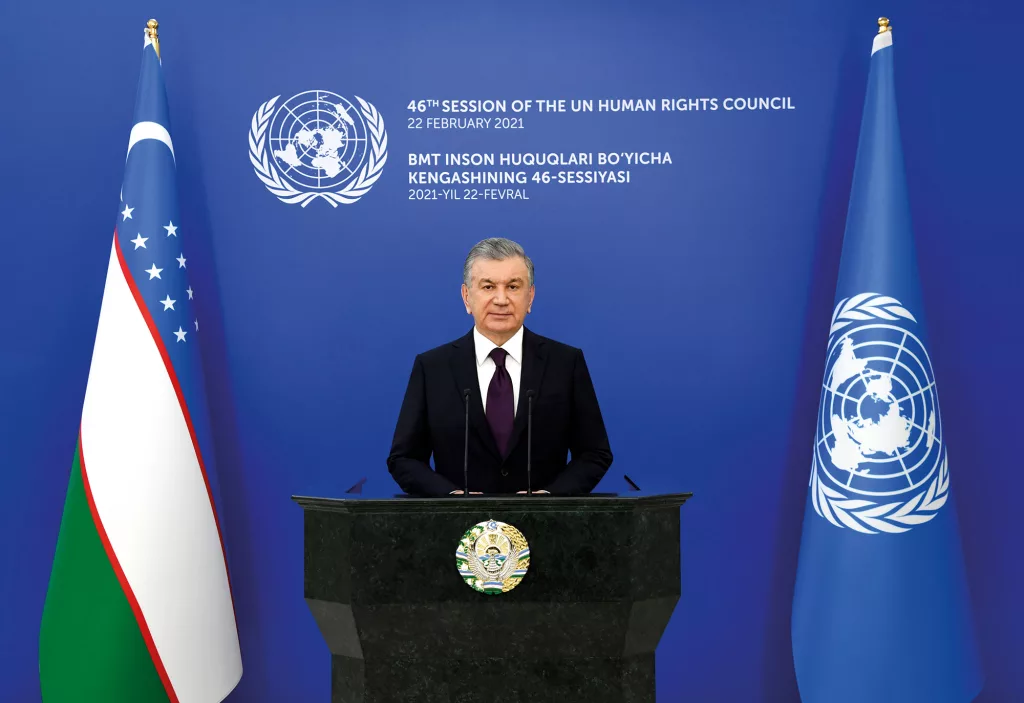
President: Shavkat Miromonovich Mirziyoyev
Humans lived in what is now Uzbekistan as early as the Palaeolithic Period (or Old Stone Age), 55,000 to 70,000 years ago. The territory of present-day Uzbekistan stemmed from an advantageous location on the ancient Great Silk Road. It became a key international junction for trade and cultural exchange, and throughout history, the people of this area have maintained relations with many regions in South Asia, the Middle East, the Mediterranean, and Eastern Europe.
It was one of the epicentres of the Islamic Golden Age — a period of flourishing enlightenment, science, culture, and philosophy which predates the Western Renaissance. Many of the philosophers and scientists of the time were born where modern Uzbekistan lies today. Avicenna (Abu Ali Ibn Sina), for example, was the author of some of the most famous books on medicine, which for nearly 500 years were part of the curriculum in leading European universities.
Amir Timur, more commonly known as Tamerlane, ruler of the Timurid Empire stretching from China to Turkey with its capital in Samarkand, established ties across Europe, seeking friendly relations, and expanding trade. Records of his correspondence with leaders in France and Spain — at one stage, he appealed to Charles VI of France to send more traders to Asia — evidenced the importance he placed on economic ties. In 1402, King Henry IV of England despatched a letter (archived at the British Library) to Tamerlane, accepting Amir’s offer of free trade between England and Timur’s empire. He was a formidable general and an enlightened ruler, whose policies gave further rise to multiculturalism and free trade.
Political Background
Incorporated into Russia in late 19th century, Uzbekistan was part of the Soviet Union until 1991. From the first days of its independence, the goal was to become a developed, sustainable, democratic state. In a relatively short period, profound structural and institutional transformations were carried out that laid the foundations of a multi-structured economy, and principles for secular, pluralistic, and democratic governance. The Economist named Uzbekistan its Country of the Year for 2019.
A large-scale reform programme by the newly-elected President Shavkat Mirziyoyev was launched in 2017, creating a milestone in the nation’s development. Progressive democratisation, based on rule-of-law, human rights and freedoms, more government accountability and openness, and improving quality of life were at the forefront of state policy.
Government policy has become increasingly focused on long-term sustainable development and economic growth, as well as social wellbeing. New strategic priorities have been established in the spheres of public administration, economic liberalisation, social policy, and foreign relations. National development guidelines have been adopted on human rights, gender equality, schools, higher education, the transition to a green and digital economy, innovative agriculture, and environmental protection.
Forced labour and child labour have been eradicated, ending an international boycott of Uzbekistan’s cotton and textiles industries. In 2020, Uzbekistan was elected to the UN Human Rights Council. The country adopted a National Human Rights and Gender Equality Strategy including ratifying the UN Convention on the Rights of Persons with Disabilities.
Human-capital development has become a priority in a country where more than 60 percent of its 36 million people are under the age of 30 and the most populous in Central Asia. The introduction of the English language and Western education standards has becoming widespread, and is considered an effective tool to counter religious extremism, radicalisation, and predominately Muslim but secular ethnically diverse country.
Broad public support for Mirziyoyev’s reformist course ensured his re-election in 2021, and the adoption of a development strategy for deeper and wider modernisation — reforms that have become irreversible. A focus on human rights and dignity, a vibrant civil society, a welfare state, and sustainable, environmentally friendly and inclusive development have been put at the heart of the transformation.
The fight against corruption has become the highest priority of state policy, with a dedicated anti-corruption agency being created.
To consolidate these important values, a major constitutional reform was initiated. Citizens have taken an active role in shaping the new constitution in a nationwide discussion. Tens of thousands of proposals from citizens were considered by a Constitutional Commission, consisting of MPs, senators, and representatives of civil society. The president has proposed initiatives for future inclusion, including the abolition of the death penalty, the establishment of Miranda Rights, and Habeas Corpus principles.
Trade & Investment
From the first days of Uzbekistan’s independence in 1991, the country set the goal of economic transformation. In a relatively short time, structural and institutional transformations were carried out. A predominantly agrarian economy, with abundant natural and human resources, has been rapidly transformed into the most diversified Central Asian economy in a blossoming, emerging market.
The reform programme has opened the country, and dramatically accelerated the liberalising economy. The doors for foreign capital and advanced technologies are actively sought by providing in law additional guarantees and benefits to investors. Uzbekistan’s place in several international rankings, including the Index of Economic Freedom, the World Bank’s Doing Business Index, the OECD Country Risk Rankings, and the World Open Data Rankings have all improved considerably.
The foreign exchange market has been liberalised. For the first time, Uzbek banks and enterprises received international ratings and entered world financial markets. International bonds in national currency were also issued. The country was admitted as a beneficiary in the EU’s GSP+ and the UK’s Enhanced GSP Scheme. The country is in the process of joining the World Trade Organisation.
Liberalisation and diversification of the economy have ensured Uzbekistan’s continued inflow of investments, as well as positive economic growth, even during the pandemic. Despite Covid, Uzbekistan maintained positive economic growth for 2020 — a global rarity. The economy grew by 7.4 percent in 2021. The latest EBRD Regional Economic Prospects project GDP growth of 6.5 percent this year, and 7.0 percent in 2024 — with 4.9 percent and 5.4 percent the respective Central Asian averages.
In 2022, GDP reached $80bn with a record of $8bn in FDI. Over the past six years, Uzbekistan has increased investment inflows to more than 30 percent of GDP. This year, it hopes to attract about $30bn in investments — of which $25bn is private. The trade turnover of Uzbekistan in 2022 increased by 18.6 percent over 2021 — up to $50bn, doubling the figure from 2016. Exports reached $19bn (15.9 percent growth), another record.
Ambitious goals have been set for 2030, including increasing GDP per capita by 60 percent, joining the ranks of upper-middle-income states, and placing $120bn into the economy — including $70bn in FDI. In 2022, a programme was introduced to ensure the “green” growth of Uzbekistan until 2030, which provides for a transition to a green economy by reducing greenhouse gas emissions, increasing the capacity of renewable energy sources (up to 15GW, and bringing the share of total volume of electricity production to more than 30 percent). There are also water-saving technologies being introduced, and expansion of green areas.
Foreign Policy
Uzbekistan has substantially changed the nature of its foreign policy. A once inward-looking country has become open, active, and responsible for regional affairs. It aims to build strong relationships with its immediate neighbours, and strengthen the long-term development, prosperity, and stability of the region.
President Mirziyoyev has initiated intensive political dialogue which has resulted in a radically improved reginal political atmosphere. Mistrust, suspicion, rivalry, and hidden hostilities have been replaced with goodwill, trust, and co-operation. Acute regional issues of the delimitation and demarcation of state borders, water-use, and transport have been resolved.
The process has received UN support. In 2018, a General Assembly resolution was adopted, entitled Strengthening Regional and International Co-operation to Ensure Peace, Stability, and Sustainable Development in the Central Asian Region. Relations are restored, the visa regime is being liberalised, new border-crossing posts are being opened, and cultural and humanitarian ties are becoming the norm. With greater connectivity and transparency, Uzbekistan’s foreign trade turnover with its neighbours has substantially increased. Over the past four years, the trade turnover between Uzbekistan with the region’s states has increased 2.6 times and exceeded $6.5bn.
Uzbekistan promotes regional security and stability and is a leading supporter of processes aimed at peaceful settlement in Afghanistan. It is actively participating in the reconstruction of the country. Due to challenges of the Aral Sea disaster, water shortages and food security, Uzbekistan is embracing efforts to control climate-change.
In addition to this strengthening of relations with other Central Asian countries, Uzbekistan pays attention to multifaceted and mutually beneficial co-operation with strategic partners and international organisations. The main goal is to address global and regional challenges — climate change, health, food, and security threats —with investments in advanced technologies, and the application of knowledge and expertise to boost the transition to innovation and a value-added economy.
Uzbekistan has striven to become one of the centres of world politics. The country hosted the summits of the Shanghai Cooperation Organisation and the Organisation of Turkic States in 2022, and dozens of high-level international conferences, where Tashkent has put forward several important initiatives. The EU-Central Asia Connectivity Conference, held in Samarkand in November 2022, focused on improving connectivity between Europe and Central Asia.
As a double-locked country, Uzbekistan promotes the diversification of transport routes to open access to world markets, participating in the processes of global integration and co-operation.
Tourism & Culture
The government has placed a priority on the development of tourism, now considered a major part of the national economy. Uzbekistan has a rich, diverse, and unique heritage, which straddles several periods of history. Uzbekistan is famous for its architectural monuments, natural landscapes, magnificent palaces and the ruins of past civilizations.
It was one of the main crossroads of trade and culture on the famous Great Silk Road. In the Middle Ages, it became a major Islamic civilization centre for culture, science, and enlightenment — which gave rise to the Western Renaissance.
Philosophers and scientists of the Islamic Golden Age thrived on the territory of current Uzbekistan. Among them were mathematician Muḥammad ibn MŪsā al-Khwārizmī — who gave us the terms algebra and algorithm — and the religious scholar Al Bukhari, the author of the second holiest source of inspiration and knowledge for Muslims after Quran.
More than any other country in Central Asia, Uzbekistan boasts a number of unique historical monuments — more than 8,000 ancient architectural and archaeological sites. The fabled cities Samarkand, Bukhara, Shakhrisabz and Khiva, all with world-class sites included in UNESCO’s Cultural Heritage List.
That list also includes less intangible cultural treasures, such as the Navruz holiday, the khorezm lazgi — considered one of the most ancient dances in the world — shoshmakom, a vocal and instrumental musical style, and bakhshi, a performance of epic poetry and stories.
Uzbekistan has a 30-day visa-free regime for citizens of 94 countries, with five days of visa-free transit for 53 countries and e-visa regime for 57. The country considers itself the most tourist-friendly country in the region, and prides itself on being ranked one of the five safest countries for solo travellers.
There is a boom in the tourism and infrastructure sectors. The government subsidises the construction of hotels, increasing year-to-year, with a plan for 64,000 rooms by 2025. The government is implementing an open-sky policy and encouraging foreign air carriers to fly to Uzbekistan.
Part two of Lord Waverley’s series will appear in our next issue: Kyrgyzstan, Tajikistan, Turkmenistan.
About the Author
Lord (JD) Waverley
House of Lords, UK Parliament
Crossbench Member
Co-chair
All Party Parliamentary group: Trade & Investment
All Party Parliamentary group: Future UK’s Freight & Logistics sector
Founder
You may have an interest in also reading…
Natia Turnava’s Appointment as Governor of Georgia’s Central Bank: A Strategic Play for Stability and Investor Confidence
Georgia’s recent appointment of Natia Turnava as Governor of the National Bank of Georgia (NBG) signals a clear commitment to
PM Shinawatra: Power through the Democratic Process
PM Yingluck Shinawatra easily survived a vote of no confidence in the Thai House of Representatives on November 28th this
UNCDF: Time to ‘Youth-Up’ – the Status Quo Simply Has to Be Adjusted
“It’s time to sustainably invest in youth affairs and future generations”, argues Edoardo Tancioni. As the world grapples with conflict,















































































